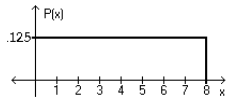500 câu trắc nghiệm Kinh tế lượng – 5A

Tổng hợp 500 câu trắc nghiệm + tự luận Kinh tế lượng (Elementary Statistics). Tất cả các câu hỏi trắc nghiệm + tự luận đều có đáp án. Nội dung được khái quát trong 13 phần, mỗi phần gồm 3 bài kiểm tra (A, B, C). Các câu hỏi trắc nghiệm + tự luận bám rất sát chương trình kinh tế lượng, đặc biệt là phần thống kê, rất phù hợp cho các bạn củng cố và mở rộng các kiến thức về Kinh tế lượng. Các câu hỏi trắc nghiệm + tự luận của phần 5A bao gồm:
SHORT ANSWER. Write the word or phrase that best completes each statement or answers the question. Provide an appropriate response.
1) Replacement times for T.V. sets are normally distributed with a mean of 8.2 years and a standard deviation of 1.1 years (based on data from “Getting Things Fixed,” Consumers Reports). (a) Find the probability that a randomly selected T.V. will have a replacement time between 6.5 and 9.5 years. (b) Find the probability that a randomly selected T.V. will have a replacement time between 9.5 and 10.5 years. These two problems can be solved by the same procedure. Draw the diagram for each and discuss the difference. Then, explain why the same procedure can be used.
For problem (a), the probability is 0.8204. For problem (b), the probability is 0.1007. The diagram for (a) shows the union of areas on both sides of the mean; the diagram for (b) shows an area to the right of the mean. Both problems can be solved by the same procedure: find the equivalent z score and associated area, i.e., probability, for each x value; subtract the smaller area from the larger area. Table A-2 facilitates this common procedure because it provides cumulative areas from the left for both negative and positive z scores.
2) The typical computer random-number generator yields numbers in a uniform distribution between 0 and 1 with a mean of 0.500 and a standard deviation of 0.289. Consider the following problems. (a) Suppose a sample of size 50 is randomly generated. Find the probability that the mean is below 0.300. (b) Suppose a sample size of 15 is randomly generated. Find the probability that the mean is below 0.300. These two problems appear to be very similar. Only one can be solved by the Central Limit theorem. Which one and why? Use the Central Limit theorem to find that probability.
Problem (a) can be solved by the Central Limit theorem. Even though the parent population is not normal, samples of size 50 are large. Their distribution will be normal. The probability is 0.0001. Problem (b) cannot be solved by the Central Limit theorem, because the sample size is smaller than 30 and the parent population is not normal. Their distribution will not be normal.
MULTIPLE CHOICE. Choose the one alternative that best completes the statement or answers the question.
Using the following uniform density curve, answer the question.

3) What is the probability that the random variable has a value between 0.6 and 1.4?
● 0.1000
○ 0.3500
○ 0.2250
○ 0.0250
Assume that the weight loss for the first month of a diet program varies between 6 pounds and 12 pounds, and is spread evenly over the range of possibilities, so that there is a uniform distribution. Find the probability of the given range of pounds lost.
4) Less than 10 pounds
○ 5/7
● 2/3
○ 1/3
○ 1/6
If Z is a standard normal variable, find the probability.
5) The probability that Z lies between -1.10 and -0.36
○ -0.2237
○ 0.4951
● 0.2237
○ 0.2239
Solve the problem.
6) A bank’s loan officer rates applicants for credit. The ratings are normally distributed with a mean of 200 and a standard deviation of 50. Find P60, the score which separates the lower 60% from the
top 40%.
○ 211.3
○ 207.8
● 212.5
○ 187.5
Find the indicated probability.
7) The weekly salaries of teachers in one state are normally distributed with a mean of $490 and a standard deviation of $45. What is the probability that a randomly selected teacher earns more than $525 a week?
○ 0.2823
○ 0.1003
○ 0.7823
● 0.2177
SHORT ANSWER. Write the word or phrase that best completes each statement or answers the question. Provide an appropriate response.
8) A recent survey based on a random sample of n = 420 voters, predicted that the Independent candidate for the mayoral election will get 24% of the vote, but he actually gets 27%. Can it be concluded that the survey was done incorrectly?
No, because of sampling variability, sample proportions will naturally vary from the true population proportion, even if sampling is done with a perfectly valid procedure.
MULTIPLE CHOICE. Choose the one alternative that best completes the statement or answers the question.
Identify the probability of each sample, and describe the sampling distribution of the sample means.
9) Personal phone calls received in the last three days by a new employee were 5, 4, and 2. Assume that samples of size 2 are randomly selected with replacement from this population of three values.
○ 1/3; 1/3; 1/18; 1/6; 1/18; 1/9; 1/6; 1/18; 1/9
○ 1/9; 2/9; 1/9; 0/9; 1/9; 0/9; 1/9; 2/9; 1/9
○ 1/8; 1/9; 1/8; 1/9; 1/8; 1/9; 1/8; 1/9; 1/8
● 1/9; 1/9; 1/9; 1/9; 1/9; 1/9; 1/9; 1/9; 1/9
Solve the problem.
10) In one region, the September energy consumption levels for single-family homes are found to be normally distributed with a mean of 1050 kWh and a standard deviation of 218 kWh. If 50 different homes are randomly selected, find the probability that their mean energy consumption level for September is greater than 1075 kWh.
○ 0.0438
● 0.2090
○ 0.4562
○ 0.2910
The Precision Scientific Instrument Company manufactures thermometers that are supposed to give readings of 0eC at the freezing point of water. Tests on a large sample of these thermometers reveal that at the freezing point of water, some give readings below 0eC (denoted by negative numbers) and some give readings above 0eC (denoted by positive numbers). Assume that the mean reading is 0eC and the standard deviation of the readings is 1.00eC. Also assume that the frequency distribution of errors closely resembles the normal distribution. A thermometer is randomly selected and tested. Find the temperature reading corresponding to the given information.